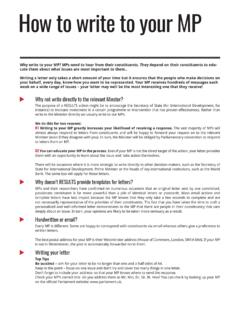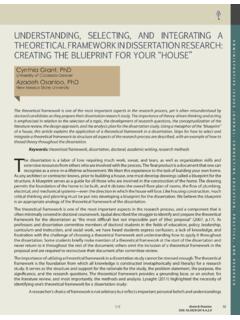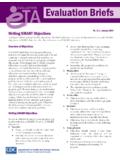Transcription of Content Analysis: A Methodology for Structuring and ...
1 United States General Accounting Office GAO March 1989 Content analysis : A Methodology for Structuring and Analyzing Written Material Transfer Paper Preface In this paper, we define and describe the evaluation method called con- tent analysis . It is a set of procedures for transforming nonstructured information into a format that allows analysis . Prom reading this paper, GAO analysts should gain an understanding of the basic concepts and procedures used in Content analysis and also an ability to recognize the appropriate circumstances for using this evaluation method in their jobs. Although we have focused on techniques that make quantitative analy- sis possible!
2 This is not necessarily the objective of all Content analyses. We have presented the techniques that are the most applicable to GAO'S work. In chapter 1, we define Content analysis and compdre it to similar procedures already used in GAO. In chapter 2, we discuss the procedures for using Content analysis . In chapter 3, we explain the advantages and disadvantages of Content analysis and describe some of its potential applications in program evaluation. The paper is designed to be self-instructional. References are provided throughout the text for readers who want more information on specific topics, and these references are keyed to the bibliography.
3 Research for this document began with a survey of the numerous books and articles on Content analysis and its past applications. We also inter- viewed users of Content analysis to gain information about its advan- tages and disadvantages, and we interviewed selected GAO staff who have participated in evaluations in which Content analysis might have been appropriate. The foundation for this document is a paper written by William Carter while a student intern with GAO. The document was prepared by Teresa Spisak, formerly of the Institute for Program Evalu- ation (now PEMD), and was originally published in 1982 as Transfer Paper 3.
4 It is being reissued now with only minor changes, including some updating of bibliographic materials. Content analysis is one of a series of papers issued by PEMD. The pur- pose of the series is to provide GAO evaluators with a clear and compre- hensive background of the basic concepts of audit and evaluation Methodology . Additionally, transfer papers explain both general and Page I Preface specific applications and procedures for using the evaluation methodol- ogy. Other papers in this series include Causal analysis , Designing Eval- Questionnaires, Using Statistical Sampling, and Case Study Evaluations.
5 Eleanor Chelimsky Assistant Comptroller General for Program Evaluation and Methodology Page2 Transfer Paper cc&en* AMlydm Page 3 Transfer Paper Content Analysb Contents Preface Chapter 1 What Is Content analysis ? 6 Chapter 2 8 What Are the Deciding to Use Content analysis 8 Procedures in Content Determining What Material Should Be Included 10 Selecting Units of analysis 10 analysis ? Developing Coding Categories 11 Coding the Material 18 Analyzing and Interpreting the Results 20 Writing the Report 22 SummarY 23 Chapter 3 25 Why Should GAO What Content analysis Can Do 25 Analysts Use Content Pitfalls in Using Content analysis 26 Potential Applications in Program Evaluation 27 analysis ?
6 Conclusion 28 Bibliography Figures Figure : Steps in Content analysis Figure : Requirements for Content Categories Figure : Matrix Category Format Figure : Category Format Measuring Space Figure : Two Category Formats Measuring Frequency of Statements 8 12 13 14 14 Figure : Measuring Frequency of and Position Taken on Specific Proposals 15 Figure : Category Format Measuring Attitude Intensity Figure : Guidelines for Contents of Coding Instructions for Trained Coders 17 18 Figure : Issues Addressed by HUD s Evaluation Units Figure : Minimum Documentation for a Content analysis Study 21 23 Page 4 Transfer Paper Content analysis Contenta Abbreviations GAO PEMD General Accounting Office Department of Housing and Urban Development Program Evaluation and Methodology Division P-6 Transfer Paper Content analysis Chapter 1 What Is Content analysis ?
7 GAO staff often collect large quantities of written material during their jobs. Workpapers, agency documents, transcripts of meetings, previous evaluations, and the like all contain useful information that is difficult to combine and analyze because it is diverse and unstructured. Content analysis is a set of procedures for collecting and organizing this information. One way to begin Structuring written material so that it can be analyzed is to summarize and list the major issues that are contained in it. Then the frequency with which these issues occur can be counted. Both activi- ties are usually performed at some point in GAO jobs, and both are part of Content analysis .
8 For example, in assessing HUD'S evaluation system to determine whether program offices were duplicating efforts, GAO analysts collected budget information, interviews, and evaluation reports. (GAO, 1978) They began analyzing the information by identifying 31 major issues for hous- ing and urban development. Then they reviewed 38 HUD evaluation reports from two offices, categorizing the issues addressed in each report and looking for overlaps between the offices. Simplifying and cat- egorizing written information are part of Content analysis . In addition to requiring summaries of written material and enumera- tions of the frequency of statements or issues, GAO projects often require more complex analyses.
9 Sometimes trends have to be examined over time, across different situations, or among different groups. The infor- mation that is needed to make these types of analysis may not exist in computer files. With Content analysis , information from written material can be structured so that these types of analysis can be made even with- out computer files. Content analysis is a set of procedures for collecting and organizing information in a standardized format that allows analysts to make infer- ences about the characteristics and meaning of written and other recorded material. Simple formats can be developed for summarizing information or counting the frequency of statements.
10 More complex for- mats can be created for analyzing trends or detecting subtle differences in the intensity of statements. Among the procedures of Content analysis that we discuss in the next chapter are defining and sampling the written or recorded material to be bibliographic references are cited in full in the bibliography. Page6 Chapter 1 What L4 Content Analyshg? analyzed, developing standardized categories, coding the material with rigorous reliability checks, analyzing and interpreting the information, and validating and reporting the results. Although in this paper we have focused on procedures that make quantitative analysis possible, this is not necessarily the objective of all forms of Content analysis .






